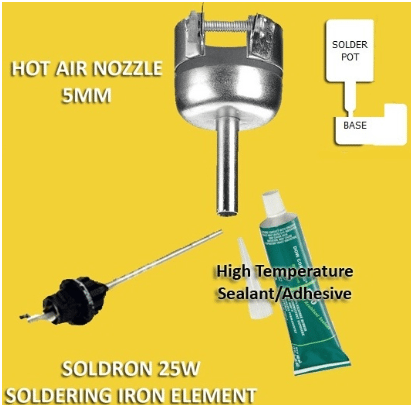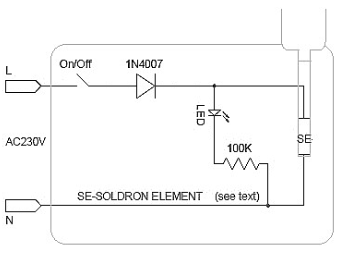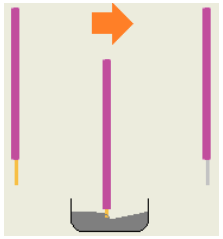
To make a great solder joint, component preparation is a must. This sounds unimportant, but it is very important to clean the component leads, wires and contact surfaces prior to soldering with isopropyl alcohol. Remember, tinning the component leads and wires will make the actual soldering of the joints quick and efficient. The act of tinning is to put a thin layer of solder on the component/wire tips, and this assists greatly in transfer of heat to the solder joints.
Once again this do it yourself project is a true recycling project — turning a popular soldering iron element into a micro-solder pot for your electronics lab. There is actually not much more to say about the hardware. At the heart of this project is a 25W Soldering Iron Element from the makers of the eternal ‘Soldron’ Soldering Iron. The second ingredient is a standard 5mm Hot Air Nozzle for the ‘Quick’ Hot-Air SMD Rework Station. To start off, simply collect the hardware as indicated in the components list, and go through the rest of this do-it-yourself guide. As you may noticed, apart from a handful of inexpensive components and accessories, no additional parts are necessary!
Major Components List
• Soldron25WSolderingIronElement–1
• Quick5mmHotAirNozzle–1
• RedLED5mm–1
• 1N4007Diode–1
• 100K1⁄4wresistor–1
• AC230VSPSTRockerSwitch–1
Mechanical Construction
The easiest way to start is first to plug the hot air nozzle directly into the tip of the soldering iron element. Then secure the nozzle over the tip using a high-temperature sealant/adhesive. Now turn the assembly over and then attach the bottom side of the soldering iron element to a suitable plastic/metal enclosure (as a solid base) with soldered-components on its innerside. The first photograph shows a real-world example constructed in this way.


Circuit Diagram
As the figure shows, the electronics is very simple and can easily be constructed on a small piece of perforated prototyping board. The AC 230V power line voltage is fed to the soldering iron element through the on/off switch. The 1N4007 diode converts the 230 VAC power line voltage into a safe power supply voltage for the soldering iron element. The red LED is a simpe power status (on/off) indicator.

The Tinning procedure
Switch on your micro-solder pot, fill the pot with adequate amount of solder wire, and let it come up to the right temperature. Next, determine the length of the wire/component lead which must be stripped, measure and clip the lead to a length slightly longer than that required by the joint. Insert the clipped end of the wire into the solder pot and wait a few seconds. Finally, slowly pull the lead back out of the solder pot. No doubt, this should produce a nicely tinned wire/component lead !

Why this DIY?
Obviously you need to strip enamelled copper wire (ECW/Magnet Wire) to prepare it for soldering. Tinning of the small gauge wire (> 18 SWG) using an ordinary soldering iron is a cumbersome task. However, you can use this home-made micro-solder pot not only to strip the ‘heat-strippable enamel’ but also to put a thin layer of solder on the stripped part. Note that wire leads which are insulated with non-heat-strippable enamel should be scraped clean before the micro-tinning process.

WARNING: This micro-solder pot is for experienced electronics hobbyists. Never permit an inexperienced person unfamiliar with heated solder tools and the characteristics of molten solder to use the device. Provide warning notice of hot pot in the area of use.










